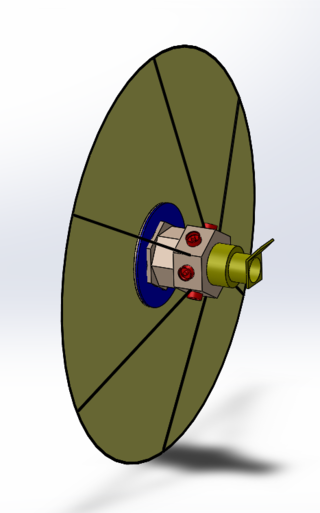
Interstellar travel is the hypothetical travel of spacecraft from one star system, solitary star, or planetary system to another. Interstellar travel is expected to prove much more difficult than interplanetary spaceflight due to the vast difference in the scale of the involved distances. Whereas the distance between any two planets in the Solar System is less than 55 astronomical units (AU), stars are typically separated by hundreds of thousands of AU, causing these distances to typically be expressed instead in light-years. Because of the vastness of these distances, non-generational interstellar travel based on known physics would need to occur at a high percentage of the speed of light; even so, travel times would be long, at least decades and perhaps millennia or longer.

The Bussard ramjet is a theoretical method of spacecraft propulsion for interstellar travel. A fast moving spacecraft scoops up hydrogen from the interstellar medium using an enormous funnel-shaped magnetic field ; the hydrogen is compressed until thermonuclear fusion occurs, which provides thrust to counter the drag created by the funnel and energy to power the magnetic field. The Bussard ramjet can thus be seen as a ramjet variant of a fusion rocket.

A starship, starcraft, or interstellar spacecraft is a theoretical spacecraft designed for traveling between planetary systems. The term is mostly found in science fiction. Reference to a "star-ship" appears as early as 1882 in Oahspe: A New Bible.

A generation ship, or generation starship, is a hypothetical type of interstellar ark starship that travels at sub-light speed. Since such a ship might require hundreds to thousands of years to reach nearby stars, the original occupants of a generation ship would grow old and die, leaving their descendants to continue traveling.
Interstellar communication is the transmission of signals between planetary systems. Sending interstellar messages is potentially much easier than interstellar travel, being possible with technologies and equipment which are currently available. However, the distances from Earth to other potentially inhabited systems introduce prohibitive delays, assuming the limitations of the speed of light. Even an immediate reply to radio communications sent to stars tens of thousands of light-years away would take many human generations to arrive.
An interstellar ark is a conceptual starship designed for interstellar travel. Interstellar arks may be the most economically feasible method of traveling such distances. The ark has also been proposed as a potential habitat to preserve civilization and knowledge in the event of a global catastrophe.

Project Daedalus was a study conducted between 1973 and 1978 by the British Interplanetary Society to design a plausible uncrewed interstellar probe. Intended mainly as a scientific probe, the design criteria specified that the spacecraft had to use existing or near-future technology and had to be able to reach its destination within a human lifetime. Alan Bond led a team of scientists and engineers who proposed using a fusion rocket to reach Barnard's Star 5.9 light years away. The trip was estimated to take 50 years, but the design was required to be flexible enough that it could be sent to any other target star.

The British Interplanetary Society (BIS), founded in Liverpool in 1933 by Philip E. Cleator, is the oldest existing space advocacy organisation in the world. Its aim is exclusively to support and promote astronautics and space exploration.

An interstellar probe is a space probe that has left—or is expected to leave—the Solar System and enter interstellar space, which is typically defined as the region beyond the heliopause. It also refers to probes capable of reaching other star systems.
X-ray pulsar-based navigation and timing (XNAV) or simply pulsar navigation is a navigation technique whereby the periodic X-ray signals emitted from pulsars are used to determine the location of a vehicle, such as a spacecraft in deep space. A vehicle using XNAV would compare received X-ray signals with a database of known pulsar frequencies and locations. Similar to GPS, this comparison would allow the vehicle to calculate its position accurately (±5 km). The advantage of using X-ray signals over radio waves is that X-ray telescopes can be made smaller and lighter. Experimental demonstrations have been reported in 2018.
In astronautics, a black hole starship is the theoretical concept of a starship capable of interstellar travel using a black hole as an energy source for spacecraft propulsion. The concept was first discussed in science fiction, notably in the book Imperial Earth by Arthur C. Clarke, and in the work of Charles Sheffield, in which energy extracted from a Kerr–Newman black hole is described as powering the rocket engines in the story "Killing Vector" (1978).
Project Icarus is a theoretical engineering design study aimed at designing a credible, mainly nuclear fusion-based, unmanned interstellar space probe. Project Icarus was an initiative of members of the British Interplanetary Society (BIS) and the Tau Zero Foundation (TZF) started in 2009. The project was under the stewardship of Icarus Interstellar until 2019. It remains a BIS project.
The 100 Year Starship project (100YSS) was a one-year joint U.S. Defense Advanced Research Projects Agency (DARPA) and National Aeronautics and Space Administration (NASA) effort "to take the first step in the next era of space exploration—a journey between the stars". The study explored development of a viable and sustainable model for persistent, long-term, private-sector investment into the myriad of disciplines needed to make interstellar space travel practicable and feasible. The goal was to examine what it would take — organizationally, technically, sociologically and ethically — to develop the ability to send humans to another star within 100 years. The study culminated in a $500,000 grant awarded to a consortium under the lead of the Dorothy Jemison Foundation for Excellence, which led to the creation of an independent organization inheriting the name 100 Year Starship from DARPA. Annual 100YSS symposia were organized from 2011 to 2015, and again in 2023.
Eberhard Grün is a German planetary scientist who specialized in cosmic dust research. He is an active emeritus at the Max Planck Institute for Nuclear Physics (MPIK), Heidelberg (Germany), research associate at the Laboratory for Atmospheric and Space Physics (LASP) in Boulder (Colorado), and was a professor at the University of Heidelberg until his retirement in 2007. Eberhard Grün has had a leading role in international cosmic dust science for over 40 years.
The Initiative for Interstellar Studies (i4is) is a UK-registered not-for-profit company, whose objectives are education and research into the challenges of Interstellar Travel. It pioneered small-scale laser sail interstellar probes and missions to interstellar objects. Several of its principals were involved in the 100 Year Starship winning team originated by NASA and DARPA.

Project Dragonfly is the first conceptual design study that assesses the feasibility of a laser-propelled interstellar probe, conducted by the Initiative for Interstellar Studies. Contrary to past unmanned interstellar mission studies such as Project Daedalus and Project Icarus, the focus is particularly on a small spacecraft. The project was founded in 2013 by the Initiative for Interstellar Studies (i4is).

Breakthrough Starshot is a research and engineering project by the Breakthrough Initiatives to develop a proof-of-concept fleet of light sail interstellar probes named Starchip, to be capable of making the journey to the Alpha Centauri star system 4.34 light-years away. It was founded in 2016 by Yuri Milner, Stephen Hawking, and Mark Zuckerberg.
Project Lyra is a feasibility study of a mission to interstellar objects such as ʻOumuamua and 2I/Borisov, initiated on 30 October 2017 by the Initiative for Interstellar Studies (i4is). In January 2022, researchers proposed that a spacecraft launched from Earth could catch up to 'Oumuamua in 26 years for further close-up studies.

Project Forward was launched in 2011 with the purpose of exploring beamed energy propulsion. The project aims to analyze and assess past beamed-powered concepts, describe the construction of sail designs, and provide a starsail system concept. Challenges include lossy divergence of the beam as well as sail design at feasible sizes.









